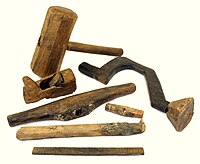
Photo from wikipedia
Intentionally produced sharp-edged stone flakes and flaked pieces are our primary evidence for the emergence of technology in our lineage. This evidence is used to decipher the earliest hominin behavior,… Click to show full abstract
Intentionally produced sharp-edged stone flakes and flaked pieces are our primary evidence for the emergence of technology in our lineage. This evidence is used to decipher the earliest hominin behavior, cognition, and subsistence strategies. Here, we report on the largest lithic assemblage associated with a primate foraging behavior undertaken by long-tailed macaques (Macaca fascicularis). This behavior results in a landscape-wide record of flaked stone material, almost indistinguishable from early hominin flaked pieces and flakes. It is now clear that the production of unintentional conchoidal sharp-edged flakes can result from tool-assisted foraging in nonhominin primates. Comparisons with Plio-Pleistocene lithic assemblages, dating from 3.3 to 1.56 million years ago, show that flakes produced by macaques fall within the technological range of artifacts made by early hominins. In the absence of behavioral observations, the assemblage produced by monkeys would likely be identified as anthropogenic in origin and interpreted as evidence of intentional tool production.
Journal Title: Science Advances
Year Published: 2023
Link to full text (if available)
Share on Social Media: Sign Up to like & get
recommendations!